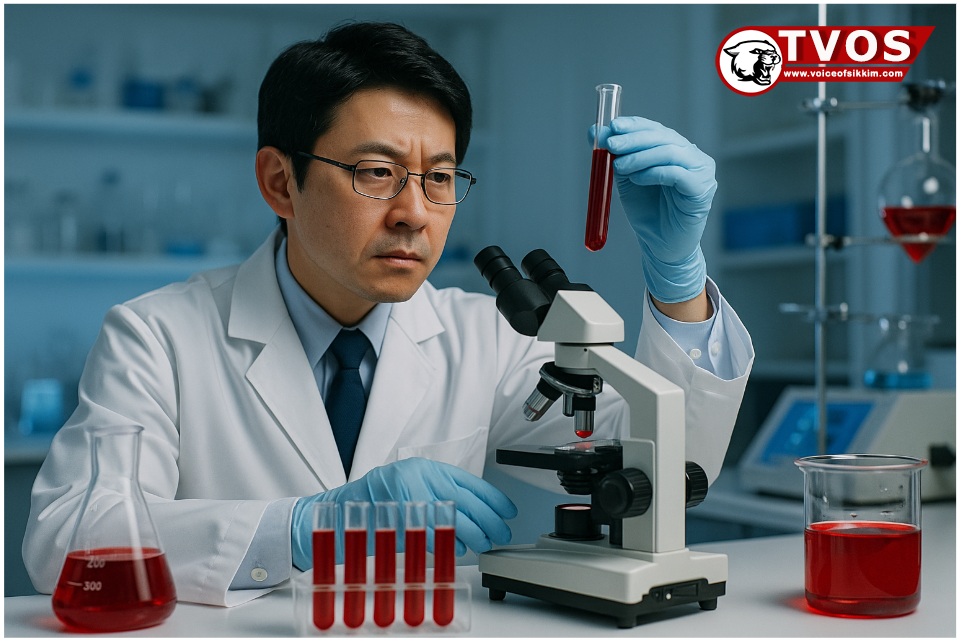
Tokyo, July 23 : In a potentially game-changing advancement for global healthcare, scientists in Japan have developed an artificial blood product that may one day replace traditional blood transfusions—without requiring blood-type matching or refrigeration.
Researchers at Nara Medical University have engineered a synthetic blood substitute designed to carry oxygen like natural red blood cells. What sets this innovation apart is its universal compatibility and long shelf life, offering a crucial lifeline in emergency medicine, particularly in regions with limited access to cold storage or blood supplies.
The artificial blood is currently undergoing clinical trials, with Japan aiming to introduce it into mainstream medical use by 2030. If successful, the country could become the first in the world to implement this technology in hospitals, operating rooms, disaster zones, and military operations.
Why This Development Matters
Traditional blood transfusions require a precise match between donor and recipient blood types—A, B, AB, or O—which can cause life-threatening delays in emergencies. Additionally, blood donations expire within six weeks and must be stored under strict refrigeration, limiting their availability in remote or resource-limited areas.
The new artificial blood addresses both issues. Developed by Professor Hiromi Sakai and her team, the synthetic blood is created by extracting haemoglobin—the molecule that carries oxygen—from expired donor blood. The haemoglobin is then encapsulated in microscopic lipid bubbles that mimic red blood cells but without the surface antigens that cause immune rejection.
This design means the product can be used on any patient, regardless of blood type, and stored at room temperature for up to two years or refrigerated for five years—a dramatic improvement over current blood storage protocols.
Clinical Trials and Safety
Initial human trials, launched in 2022, have shown encouraging results. Volunteers were able to tolerate the artificial blood with no significant side effects, according to reporting by Tokyo Weekender. Current phases of testing involve larger transfusion volumes, ranging from 100 to 400 millilitres, to assess the effectiveness and safety at scale.
Beyond trauma care and surgery, this innovation could also transform battlefield medicine, remote healthcare delivery, and disaster relief operations, where access to compatible blood is often limited.
Professor Sakai emphasized the speed advantage in emergency situations: “Matching blood types takes time. Artificial red cells remove that barrier, making transfusions faster and potentially life-saving,” she noted in an interview with The Japan Times.
Global Implications
With the World Health Organization continuing to highlight the global shortage of safe blood, Japan’s breakthrough could offer a scalable and efficient solution. If adopted globally, artificial blood might significantly reduce pressure on blood banks and eliminate compatibility issues, paving the way for more equitable and rapid care in critical situations.
As research progresses, medical professionals around the world are watching closely. The success of this synthetic blood could mark the beginning of a new era in transfusion medicine—where blood type no longer dictates survival.
Japanese Scientists Create Universal Artificial Blood With Extended Shelf Life, Offering Hope for Global Shortages
Tokyo, July 23: In a major medical breakthrough, researchers in Japan have developed a universal artificial blood that could reshape emergency medicine and ease global blood supply crises. Engineered to replicate the core functions of natural blood, this innovative substitute is capable of transporting oxygen throughout the body — regardless of the recipient’s blood type.
The development comes at a time when healthcare systems around the world are grappling with persistent shortages in blood donations, particularly the rare and highly sought-after O-negative type. Traditional blood banking is often hampered by limited shelf life, supply-demand imbalance, and logistical challenges in storage and transport. Scientists at Nara Medical University, led by Professor Hiromi Sakai, may have found a solution that overcomes these limitations.
A Technological Leap in Blood Replacement
The artificial blood, known as haemoglobin vesicles (HbVs), is created by encapsulating hemoglobin derived from expired donor blood into tiny lipid-based spheres. Each artificial cell is about 250 nanometres in diameter and distinctively purple in color. Unlike red blood cells, these synthetic vesicles lack blood type markers, allowing them to be administered to anyone without the need for cross-matching — a critical advantage during emergencies.
What sets this substitute apart is its impressive shelf life. While donated blood typically expires within 42 days, HbVs can be safely stored for up to two years at room temperature, making it ideal for remote areas, military use, and disaster response.
How It Works
Artificial blood functions by closely imitating the oxygen-carrying properties of real red blood cells. Once introduced into the bloodstream, the vesicles travel through the circulatory system, delivering oxygen to organs and tissues just like their biological counterparts. Their virus-free, lab-produced nature also minimizes the risks of infection and transfusion-related complications.
A Step Toward the Future of Transfusion Medicine
Early experimental trials have shown promising results, and researchers are optimistic about its potential to revolutionize trauma care, surgery, and critical care medicine. If widely approved, this universal artificial blood could dramatically reduce dependence on traditional donors and address disparities in blood availability across low-resource settings.
With continued research and regulatory progress, Japan’s lab-made blood may soon mark the beginning of a new era in transfusion science — one where every drop is engineered for safety, longevity, and universal compatibility.






